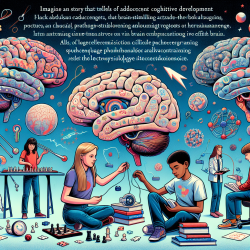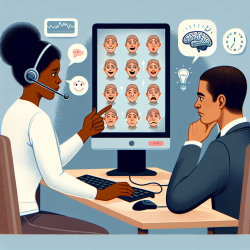Introduction
As practitioners in the field of speech-language pathology, understanding the cognitive development of adolescents is crucial for enhancing therapeutic outcomes. Recent research titled "Error processing in the adolescent brain: Age-related differences in electrophysiology, behavioral adaptation, and brain morphology" offers valuable insights into how error processing evolves during adolescence. This blog post will explore the key findings of this research and discuss how practitioners can leverage these insights to improve their practice.
Understanding Error Processing in Adolescents
The ability to detect and react to errors is a fundamental cognitive skill that continues to develop throughout adolescence. The study examined the development of error processing using electrophysiological markers, specifically the error-related negativity (ERN) and error positivity (Pe). These markers are associated with the brain's response to errors and subsequent behavioral adjustments.
The research revealed that ERN amplitude, which reflects the brain's automatic response to errors, increases with age. This suggests that adolescents become more adept at detecting errors as they mature. In contrast, Pe amplitude, which is linked to conscious error awareness, remains stable across age groups. This indicates that the capacity for conscious error detection matures earlier in childhood.
Implications for Practitioners
For practitioners, these findings underscore the importance of tailoring interventions to align with the developmental stage of the adolescent brain. Here are some actionable strategies:
- Focus on Automatic Error Detection: Since ERN amplitude increases with age, interventions should aim to enhance automatic error detection in younger adolescents. This can be achieved through repetitive practice and feedback mechanisms that encourage quick error recognition.
- Enhance Conscious Error Awareness: Although Pe amplitude remains stable, reinforcing conscious error awareness can still be beneficial. Practitioners can incorporate activities that require adolescents to reflect on their errors and consider alternative strategies.
- Leverage Behavioral Adaptation: The study found that post-error slowing and improvement in accuracy increase with age. Practitioners can design tasks that encourage adolescents to slow down and focus on accuracy following an error, thereby reinforcing adaptive behaviors.
Encouraging Further Research
While this study provides valuable insights, there is still much to learn about the neural mechanisms underlying error processing in adolescents. Practitioners are encouraged to stay informed about ongoing research and consider participating in studies that explore these cognitive processes further. By doing so, they can contribute to a deeper understanding of adolescent brain development and enhance their therapeutic practices.
Conclusion
Understanding the intricacies of error processing in the adolescent brain is essential for speech-language pathologists aiming to optimize therapeutic outcomes. By integrating the findings from recent research into their practice, practitioners can better support the cognitive development of adolescents. For those interested in delving deeper into the original research, please follow this link: Error processing in the adolescent brain: Age-related differences in electrophysiology, behavioral adaptation, and brain morphology.










